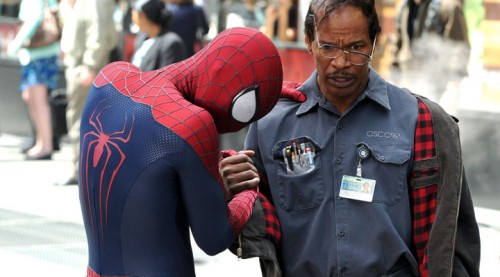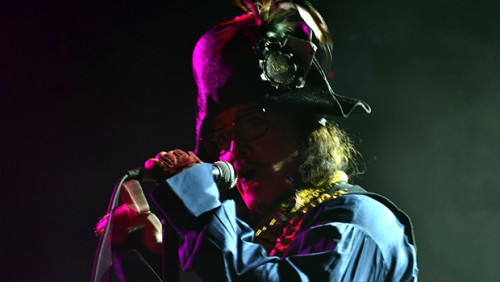By Greg Popil
Spider-Man does look genuinely amazing in “The Amazing Spider-Man 2.” Sequences showing Peter Parker’s alter ego swinging between skyscrapers or sharpshooting web strands to catch bad guys or save innocent bystanders look cleaner, crisper and more wince-inducing than was ever dreamed possible. But therein lies the problem: All of the action described above has already been done, four times in the past 12 years alone, and this is just a prettier variation of it. Sony Pictures may have rebooted the Spider-Man franchise three years ago, but this still feels very much like the fifth movie in the series, and the fatigue is showing.
It’s impossible to talk about these movies without acknowledging web-slinging elephant in the room: Sam Raimi’s original, largely awesome trilogy. By the time he got to 2007’s “Spider-Man 3” Raimi was clearly burnt out, but even that movie, lame dance sequences and all, bristled with its creator’s personality. The new series falls to the perfectly named Marc Webb, who helms the tale of Peter’s graduation, yet again, and first tentative steps into the real world, working as a photographer, yet again. Parker (Andrew Garfield) must balance these responsibilities with his conflicted feelings about girlfriend Gwen Stacy (Emma Stone) and battling a multitude of villains.
The most interesting of these antagonists is Max Dillon (Jamie Foxx), a lonely, socially awkward OzCorp engineer that is saved by Spider-Man, and immediately develops an unhealthy obsession with him. After an accident in OzCorp’s lab (how do all science laboratories in the Marvel Universe not have armed guards and machine gun turrets at this point? It seems like there’s a new monster bursting out of one every other week), Dillon becomes Electro, who can channel all electricity into his own power. Davis is a new element for the series: a superhero Mark David Chapman, internalizing his own feelings of inadequacy and rage, fantasizing about a relationship with Spider-Man, until he literally explodes. Foxx, coming off a career-best performance in “Django Unchained,” is great here, making Electro a genuinely sad, misunderstood monster. The first confrontation between the two is easily the best scene in the movie, with Spidey attempting to talk down a scared, confused Electro, until his obsession and resentment forces him to turn to violence.
This is great stuff for a superhero movie, but unfortunately there is much, much more. The four credited writers also manage to stuff in another Harry Osborn subplot. This time out Harry’s father Norman (Chris Cooper) dies in his first scene, but first tells Harry that he has a genetic disease which will slowly kill him too, and Harry believes that the key to his cure is Spider-Man’s blood. There’s also an investigation into the deaths of Peter’s parents, a cameo by another villain (Paul Giamatti), and a couple of scenes that tap into post-9/11 fears of planes crashing in New York. “Spider-Man 3” was not nearly as bad as fan-boys make it out to be, but it was gratuitously overstuffed with plot, a mistake that this series has only taken a single sequel to repeat.
The Harry Osborn subplot has its moments. Newcomer Dane DeHann is not given the time to develop the character that James Franco was, but he does well with what he is given, playing Osborn like a cold, Bret Easton Ellis-esque rich kid, trying hard to reconnect with Peter from the other side of a mountain of privilege. His later transformation into a familiar foe is unfortunately rushed: this could have been its own movie, but Sony seems intent on rushing into a Sinister Six showdown, unconcerned with the patience that Marvel Studios took in building its vast universe over the past six years.
As a director, Webb seems like he wants to follow in Raimi’s footsteps when it comes to making these movies fun, but he doesn’t truly have his heart in it. Best known for directing the Zooey Deschanel rom-com vehicle “(500) Days of Summer,” Webb is most comfortable working with scenes where Garfield and Stone get to act adorable together, of which there are quite a few. Both leads remain a lot of fun, especially Garfield, who restores some of Spider-Man’s nasty sarcasm in relief of Tobey Maguire’s oftentimes overly earnest performance. A scene where Parker, sans mask, helps Stacey avoid OzCorp thugs is a lighthearted delight. But Webb seems hesitant to buy into the nuttiness of the premise. This is a movie with an evil doctor, complete with terrible German accent, torturing a patient, and a super-villain that is created by falling into a tank of electric eels. Raimi would have fiercely committed to the nuttiness of these scenes (one could easily imagine Bruce Campbell playing the evil German doctor). Webb puts his head down and pushes through these weird flourishes as quickly as possible, to get back to Parker mooning over his girl or his dead parents.
It feels a bit unfair to endlessly compare these movies to the trilogy that preceded them, but given how little time Sony allowed before rebooting, it also feels inevitable. And make no mistake, the studio is the main force here, rushing reboots and sequels into production to make sure the rights to the characters don’t revert back to Marvel. The movie doesn’t have an unsafe bone in its body; it’s virtually impossible to imagine the filmmakers taking the kind of comic book geek-stoking chances that “Iron Man 3” took with familiar characters. When it sticks to dipping, swinging and flying, “Amazing” lives up to the first part of its title. But at the end of the day, it’s simply the prettiest paint-by-numbers picture you’ll ever see.
Rating: 44/81




Leave a Reply